
by Rick O'Connor | Jan 16, 2015
Beginning this month we will be posting a series of natural resource articles high lighting Florida’s Panhandle. The photographs and hikes presented in this series are from Escambia and Santa Rosa counties but the same natural places can be found anywhere between the Perdido and Apalachicola Rivers. We hope our readers will visit these places and DISCOVER FLORIDA’S PANHANDLE on their own. This year we will begin at the Gulf of Mexico and visit our BARRIER ISLANDS. We will visit the same location on Santa Rosa Island in Escambia County each month over the course of a year. During this series we should see how things change each season and learn more about our natural places.

The Gulf of Mexico at sunrise. Photo: Rick O’Connor
Here is the Gulf of Mexico. The northern Gulf is primary sand but their are areas of hard bottom that provide habitat for many of our commercial important fisheries. 450 feet off the shore from this photo is an artificial reef placed by Escambia County for residents and visitors alike to explore. These reefs attract a variety of reef fish and sea turtles and are great for wildlife viewing. Notice how low the sun is in the sky on this winter morning. The shortest day of the year was December 21 (when the sun was it’s lowest) and will be “climbing” as this series continues. Many beach residents use this as their clock!
Our barrier islands are considered the “world’s whitest beaches” and this is because of the high amount of quartz deposited here. In this photograph you can see the water is farther from shore than usual. This is due to the strong north winds blowing water offshore; this happens every winter – but provides feeding opportunities for shorebirds. The sand fencing is used by many of our counties to “kick start” dune restoration.

Primary dune line with sand fencing. Photo: Rick O’Connor
Beyond the primary dune on this portion of the island you will find low areas known as swales. These “depressions” will fill with water during rain events and provide much needed freshwater for the organisms who live out here. Barrier islands are xeric environments (meaning “desert like”) and freshwater habitats are very important for many creatures. Some of these ponds are ephemeral (meaning non-permanent) and dry up during some periods of the year.
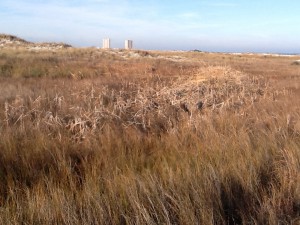
Swale with dead cattails. Photo: Rick O’Connor
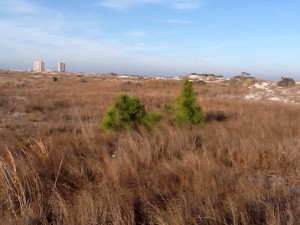
Small pines on the edge of a swale. Photo: Rick O’Connor
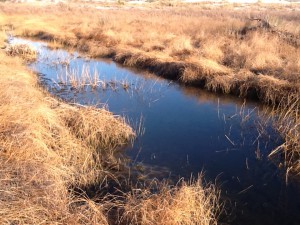
The water in most swales is freshwater. Photo: Rick O’Connor
Where the primary dune and swales end the secondary dune fields begin. Because of the primary dunes there is less wind and salt spray which allows different species to take root. The secondary dunes are often identified by their small round shrubs – such as goldenrod and beach heather. These larger plants will trap larger amounts of sand producing larger dunes. On the secondary dunes I usually find lots of tracks. Identifying tracks is difficult (especially in soft sand) but fun. Most of what I saw this winter day were mammals. Raccoons, opossums, and armadillos are very common. Skunks were once common but have been scarce since the hurricane years. Below are tracks of a canine. Many people bring their dogs to the beach but coyote and fox are also found here. These tracks measured about 3.5″ and more round than triangle shaped; suggesting this is a dog.
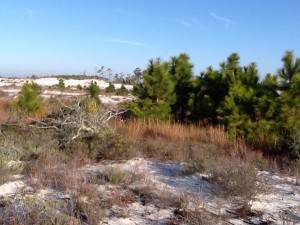
Small secondary dune with small pine trees.
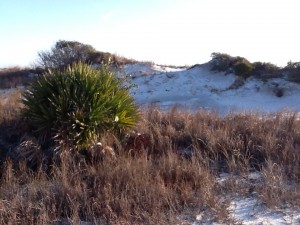
This secondary dune supports a saw palmetto. Many forms of wildlife depending on these shrub areas.
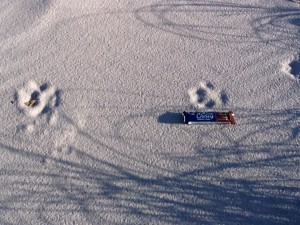
These unidentified canine tracks are probably of a dog; though coyotes are on our islands
Beyond the secondary dunes are the largest dunes on the island, some measuring over 50′, these are the tertiary dunes. With the secondary dunes blocking wind and salt spray larger plants still are allowed to grow. Here we find actually trees; pine, live oak, magnolia to name a few. With the loss of primary and secondary dunes the tertiary dunes are exposed to the wind and salt spray of the Gulf side, which puts them at risk. This is why sea oats and primary dunes are protected in most counties.
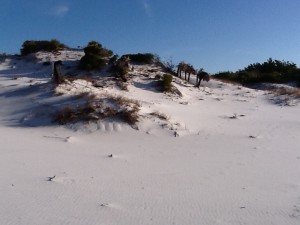
The face of a tertiary dune. Photo: Rick O’Connor

Tertiary dunes are the largest dunes on the island; some reaching over 50′.

Tertiary dunes support trees such as this magnolia and yaupon holly.
The large field of tertiary dunes blocks enough wind that forests and salt marshes can establish themselves on the back side of the island. Here the diversity and abundance of wildlife increases. We have found not only the mammals already mentioned but snakes, freshwater turtles and terrapins, and a variety of birds. This winter day I found several small woodland and mocking birds. Some of our islands have deer and alligators.
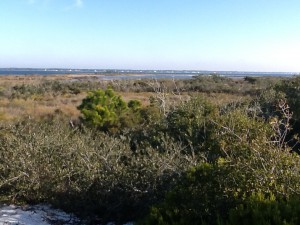
From atop a tertiary dune you can view the maritime forest, salt marsh, and sound beyond. Photo: Rick O’Connor
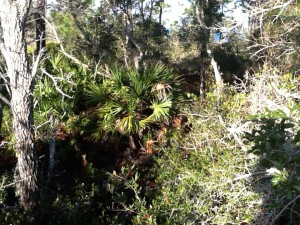
Within the maritime forest you will find a variety of plants and animals.
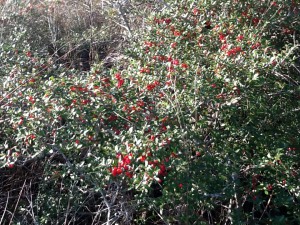
Holly’s are famous for having the bright red berries around Christmas time. Here in January the berries are still found on some of them.
Between the maritime forest and the salt marsh you may find freshwater ponds. Like the swale ponds, these places are great places to find wildlife. Though I have not seen them in many years I have found alligators in this area. These ponds support populations of amphibians and small fishes.
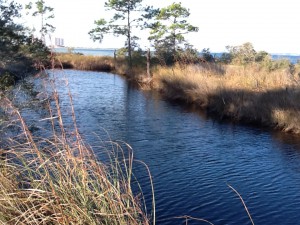
This freshwater pond has bull minnows, amphibians, snakes, and – in the past – alligators. Photo: Rick O’Connor

With the dunes blocking offshore winds trees can grow much larger on the back side of the island; like this live oak.
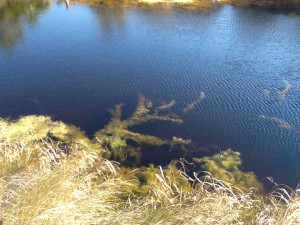
This pond supports a stand of green algae which supports many of the aquatic animals that visit here.
On this winter day I primarily saw bird life. The air temperature was 39 F and the wind was out of the north. Many of the mammals move at night and the reptiles, being cold blooded, were hibernating somewhere; the bird life however was pretty active. Many woodlands birds were out feeding on seeds and berries, herons and egrets were in the marsh hunting fish in the shallow waters, and shorebirds were picking through the beach wrack and some were diving.
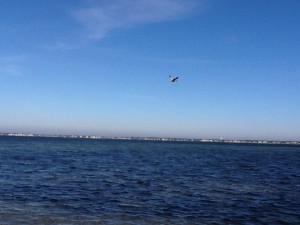
This pelican is searching over Santa Rosa Sound for a fish to feed on. Photo: Rick O’Connor
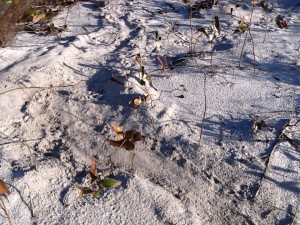
This unusual drag was found between the salt marsh and the sound side shoreline. It looks like a turtle crawl but at his time of year more probable something being dragged by something.
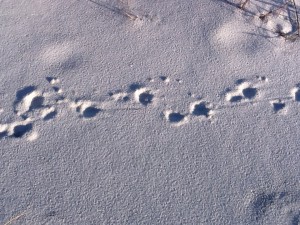
Armadillo tracks can be identified by their “tail drags”.
Salt marshes are one of the most productive systems on earth; and the target for another FLORIDA’S PANHANDLE series. Crabs, shrimp, mollusk, worms, terrapins, fish, and birds are some of the wildlife that call this place home – and maybe we will find some as this series continues into the warmer months. Today I found pelicans, herons, and egrets here eating.
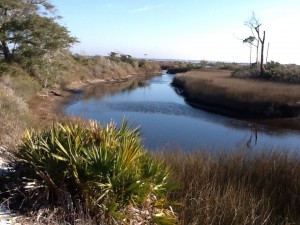
A finger of a salt marsh on Santa Rosa Island. The water here is saline, particularly during high tide. Photo: Rick O’Connor
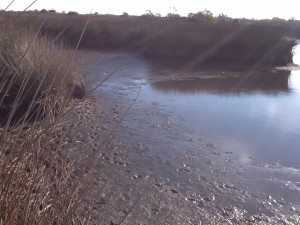
The muck of a salt marsh. This rich organic mud is very loose and the hiker can quickly sink! Notice the tracks of a predator.
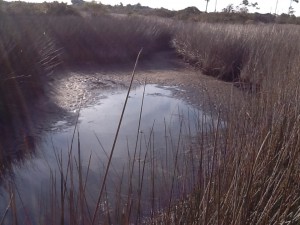
Notice the low water levels typical of winter. This congregates fish into smaller pools and makes it easier for birds and mammals to catch them.
The Sound side of the island has wind but less wind than the Gulf side. The wave energy here is also lower supporting seagrass and oyster communities. Like the marsh these places are very productive; though all I really saw moving on this cold winter morning were the birds. There are two species of seagrass common to our sounds; turtle grass and shoal grass. However there have been reports of more tropical species appearing. We may find some when the water warms up. These waters support at least 100 species of fish and many invertebrates we enjoy eating.

The darker areas in the water are seagrasses. Photo: Rick O’Connor
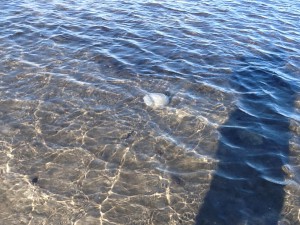
I found this along the shore last winter. These are cannonball jellyfish.
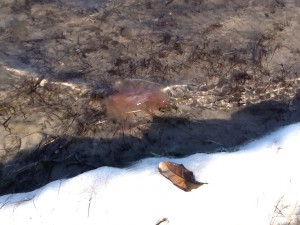
This is a sea nettle. This species of jellyfish has a more painful sting. I only saw one of these today but saw several cannonballs.

People find this “sea foam” frequently when they visit the beach. It is formed when the winds pick up and there are nutrients in the water. It was up and down the beach today.
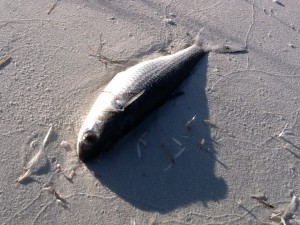
It is not uncommon to find dead fish along the shore after a hard freeze as we have had in recent weeks. When it warms these dead fish will attract scavengers including cottonmouths. Maybe we will see one later in the year.
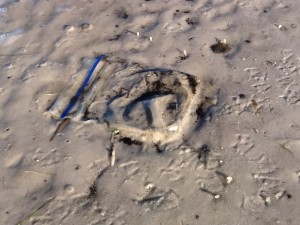
There was very little trash on the island today but it was there. These pieces of debris can cause serious problems for coastal wildlife. We will discuss this issue more as this series moves on.
Well, for January we found the beach to be cold and windy. Very little wildlife was out to be viewed other than birds and the numerous tracks in the dunes, but as the temperatures warm we will see more. Take some time to visit our barrier islands and enjoy them. Until February.
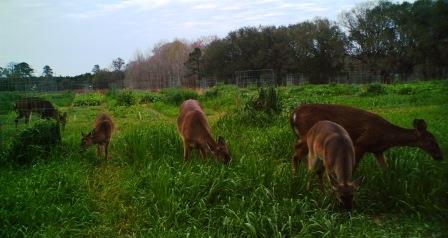
by Mark Mauldin | Dec 5, 2014

Deer grazing test plots at the NFREC in Quincy. Quality food plots take effort and planning.
Deer hunting season has begun in Northwest Florida. As hunters venture into the woods and sit for hours on end they have plenty – sometimes too much – time to contemplate what they could have done or should do to make there hunting experiences better. These plans for improvement may involve all kinds of things; if they involve improving underperforming food plots allow me to offer a few points for contemplation.
- Are your plots the optimum size? Small plots, less than one acre, don’t stand much of a chance. If you plant something deer like and there is a substantial deer population in the area the young plants will be “mowed” down before they have time to establish. At best, you’ll create a low growing green carpet. This might make you feel better as a hunter but it’s doing very little in the way of providing nutrition to the deer herd. Deer will get the maximum benefit from multiple plots (2-3 acres in size) that total around 10% of the area you are managing. This scenario is ideal for the deer, it might not be ideal or even feasible for the hunter.
- Are your plots properly fertilized? This is a very common issue with underperforming food plots. That bag of 10-10-10 really doesn’t do much. Hunters who have no farming experience are often amazed and disheartened at how much fertilizer it takes to produce a crop – food plots are simply forage crops. Consult your county’s agriculture agent for assistance with soil testing and fertilizer recommendations for the specific crops you are producing. UF/IFAS fertilizer recommendations for forage crops reference additional applications after a grazing rotation or haying; how does this translate for food plot management? A cool season food plot planted in mid-October will be productive for about six months. During that six months you should apply Nitrogen at least three times, Potassium twice, all required Phosphorus can be applied at planting. This steady supply of nutrients keeps the food plot going throughout the entire growing season. Using slow release or enhanced efficiency fertilizers can simplify this process somewhat, since the number of applications is reduced.
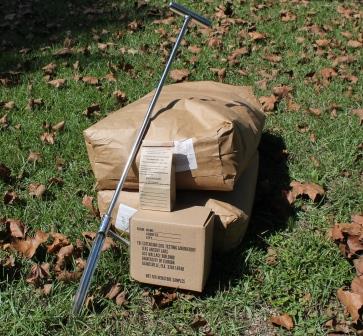
Soil testing and the resulting fertilizer recommendations are key to successful food plots.
- Did you plant the right crop at the right time? There are lots of choices when it comes to selecting what to plant in your food plots remember plant varieties that are suited to your particular environment not the one that have the prettiest packaging or the most TV commercials. Planting time can be an issue; when cool season crops are planted too late they are unable to establish enough roots and top growth to withstand grazing pressure through the middle of winter when short days and cold temperatures greatly slow growth rates. Even if planted at the correct time most “winter” forages produce the majority of their biomass in the spring, once day length begins to increase.
Hopefully considering these points will help you to improve your food plots. Remember, producing high quality food plots can be a challenging endeavor but the process makes more sense and is less frustrating if you view food plots as long term habitat improvement designed to provide additional nutrition to the deer herd not simply an attractant during hunting season. For more information on any of the topics addressed contact your county’s UF/IFAS Extension Agriculture or Natural Resources Agent.
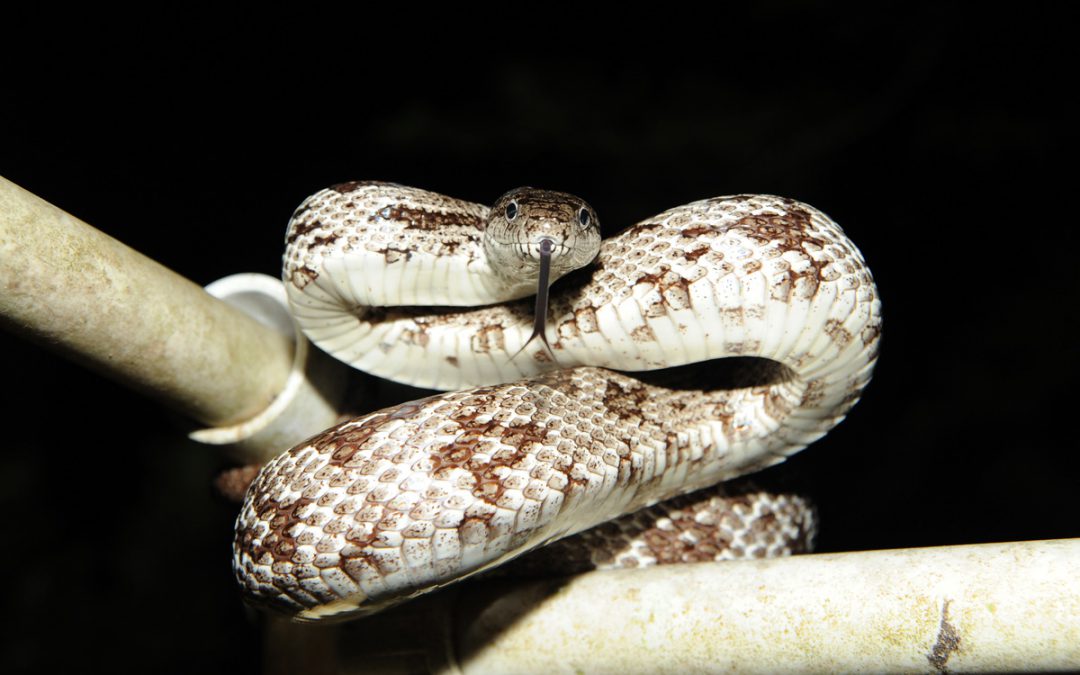
by Rick O'Connor | Oct 10, 2014
In the last few weeks we have received an increase in calls about snake encounters. Most of these have dealt with small juvenile snakes folks are finding on their property, or in their homes, but we are also hearing about large ones.
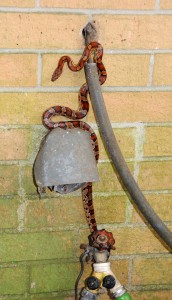
Corn snakes are excellent climbers and consume a lot of rodents.
Photo: Nick Baldwin
Most of the 56 species of snakes found in the southeastern United States breed in spring or summer and this time of year people begin to encounter the juveniles from this year’s brood. The Southern Black Racer has been the most common encounter we have heard from and this is because the young do not resemble the adults at all. But panhandle residents should be aware that there are several species who do breed in the fall and the adults will be seeking each other this time of year increasing your chances of an encounter. Of those that do breed in the fall 16 can be found in the panhandle.
Three of these species are small terrestrial snakes. They would include the Florida Red-Bellied Snake, the Southeastern Crown Snake, and the Southern Ringneck Snake. These are typically less than 15” in length and move at night. They frequent the underbrush where they hunt for insects and small amphibians and are no threat to people or pets.
There are 4 species of local mid-sized snakes that are fall breeders. The Rough Green Snake, Eastern Garter Snake, Eastern Hognose Snake, and the Scarlet Snake are all very common and pose no threat to people and pets. The Green Snake and Scarlet Snake can be found in around trees this time of year and the Eastern Hognose is often confused with the Pygmy Rattlesnake. Hognose differ in that they have round pupils and an upturned nose; of course they lack a rattle as well. Scarlet snake is confused with the Eastern Coral Snake but can be distinguished but their red head (instead of black).
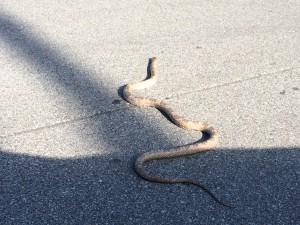
Gray rat snake crossing a driveway.
Photo: Carrie Stevenson
Of the 8 species of large terrestrial snakes only 2 are known to breed in the fall locally. These would be the Gray Rat Snake and the Eastern Indigo. Both of these snakes can easily reach 6 ft. in length and tend to terrify people but in reality these are both rather docile and consume a significant number of disease carrying rodents; Indigos will actually feed on venomous snakes helping to control their populations. The Eastern Indigo Snake has not been seen in the Florida panhandle since the late 1990’s and is current listed as an endangered species in our state.
We have 15 species of non-venomous water snakes in the southeastern U.S. but only 1 local is a fall breeder; the Queen Snake. This snake is found in all panhandle counties except those along the coastal portion of the Apalachicola River; Bay, Gulf, Franklin, and Wakulla counties. As a group water snakes tend to be aggressive, and some can be quite large, but they pose no danger to people and pets.
Finally the ones most are concerned with. There are 6 species of venomous snakes in the southeastern U.S. All 6 can be found in the panhandle and all 6 breed in the fall. This means that males will be out seeking females and encounters could occur. Copperheads are rare in Florida but are most often encountered along the region of the Apalachicola River. These snakes tend to be cryptic and move very little. They will release a musk to warn that you are getting to close. There are 2 subspecies of Cottonmouths in the panhandle. The Florida Cottonmouth is found in the coastal counties of the Apalachicola River (mentioned) and the Eastern Cottonmouth is found elsewhere. They prefer water but will move upland during the cooler months. They have a reputation of being aggressive but are actually no more aggressive than other snakes. Like most, they are trying to avoid you. The Eastern Coral Snake is the only neurotoxic snake in our state. This animal moves through the underbrush seeking prey, including other snakes. They are rarely encountered but are quite common.
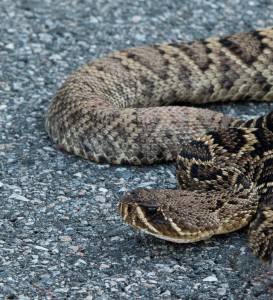
The familiar face of an Eastern Diamondback Rattlesnake.
Photo: Nick Baldwin
Then there are the most feared of the group – the rattlesnakes. The Timber Rattlesnake is actually not that common in Florida but many travel to Georgia and Alabama during deer season where they are common. The Eastern Diamondback and the Dusky Pigmy Rattlesnakes are common here. All three species breed in the fall and could be encountered this time of year.
Many of our local snakes will den during these cooler months and some in groups. All should be aware of this when exploring stump holes and such while visiting the outdoors. Also know that on warm sunny days they may venture out to bask in the sun; another chance to encounter them.
For more information on how to handle an encounter or a snake bite visit the Escambia County Extension website ( http://escambia.ifas.ufl.edu ) or contact Rick O’Connor at 850-475-5230; roc1@ufl.edu .

by Carrie Stevenson | Sep 12, 2014
 The UF/IFAS Extension Escambia and Santa Rosa counties and Naturally EscaRosa would like to invite agritour and ecotour providers to the 2014 Agri/Eco-tourism Business Development Conference on November 5-6, 2014. The conference is geared for businesses wishing to enhance and develop their offerings.
The UF/IFAS Extension Escambia and Santa Rosa counties and Naturally EscaRosa would like to invite agritour and ecotour providers to the 2014 Agri/Eco-tourism Business Development Conference on November 5-6, 2014. The conference is geared for businesses wishing to enhance and develop their offerings.
Owners, operators and employees of u-pick operations, fresh produce markets, corn mazes, pumpkin patches, wildlife/bird watching, paddling, camping, fishing, etc. tourism businesses or those considering starting a similar business are invited to attend this event.
The conference will be an exciting blend of informational sessions, hands on activities, and an opportunity to explore local agritourism and ecotourism businesses. The conference will provide important information for new business startups as well as long established companies in the field.
The keynote speaker, Eric Eckl, will provide information on messaging and direct marketing campaigns. Other topics in the educational program include: starting a business, liability, local success stories, liability, staffing, benefits, & healthcare.
The conference will be held at Adventures Unlimited at 8974 Tomahawk Landing, Milton, Florida 32570. The conference begins at 9 am Nov. 5 and runs through the afternoon of Nov. 6, 2014. Conference registration is $25.00, to register go to: http://santarosa.ifas.ufl.edu/agritourism-ecotourism-conference/
For more information on the 2014 Gulf Coast Agritourism & Ecotourism Business Development Conference, contact Chris Verlinde (850) 623-3868 or Carrie Stevenson (850) 475-5230.
by Erik Lovestrand | Aug 18, 2014
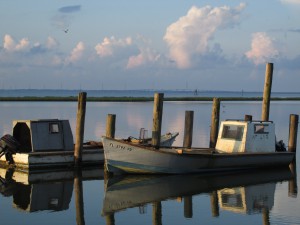
Oyster Boats on Apalachicola Bay
Photo by Erik Lovestrand, UF/IFAS Franklin County Extension Director
A notice has been issued by the California Dept. of Public Health dated June 27 that is seeking public comment on a proposed rule change regarding the allowable level of microbial Vibrio vulnificus in post-harvest processed Gulf oysters.
Post-harvest processed oysters are regulated as raw, but have been subjected to a process to reduce levels of Vibrio vulnificus. The current rule states that levels must be less than 3 MPN/g (Most Probable Number/gram) whereas the proposed change would allow a critera of less than 30 MPN/g of Vibrio vulnificus. Restrictions regarding raw Gulf oysters harvested during April through October that have not undergone post-harvest processing to reduce Vibrio vulnificus will remain in place.
This change would bring California’s molluscan shellfish regulations into alignment with standards adopted by the National Shellfish Sanitation Program of the U.S Food and Drug Administration (FDA) and the Interstate Shellfish Sanitation Conference (ISSC). All other member states of the ISSC have already adopted the less than 30 MPN/g standard in post-harvest processed oysters.
This newer standard has been deemed safe since it has been in use from 2005 with no documented Vibrio vulnificus infections associated with raw oysters processed at the less than 30 MPN/g level according to FDA data. This change is anticipated to increase the amounts and varieties of post-harvest processed oysters imported into California from Gulf states.
If you would like to see materials regarding this action you may access them here. Inquiries about the proposed regulations may be directed to Pat Kennelly, Chief, Food and Drug Branch, Food Safety Section, at (916) 650-6598.
Article Author Contact:
Erik Lovestrand
UF/IFAS Franklin County Extension Director
Sea Grant Regional Specialized Agent II
653-9337
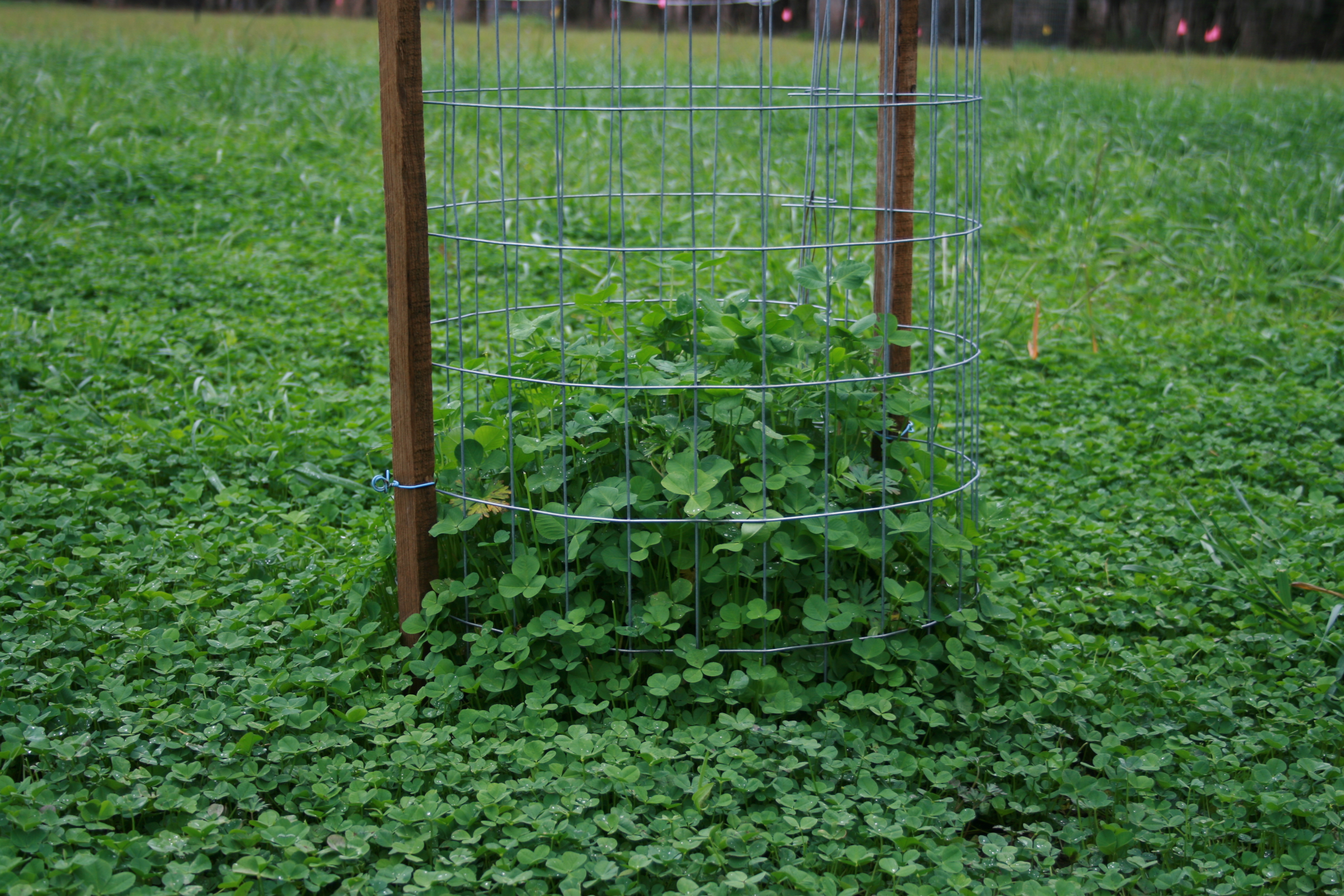
by Jennifer Bearden | Aug 15, 2014
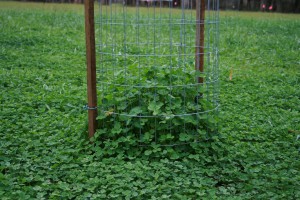
Exclusion cages help us determine how much forage is being produced and consumed. (photo by Jennifer Bearden)
It’s time to start planning your cool season wildlife food plots. Cool season food plots do a great job attracting deer and other wildlife to your property as well as providing a little nutrition. The first step is to choose an appropriate location. Remember wildlife like to stay close to cover but plants also need sunlight. Cool season food plots are generally smaller than warm season food plots (about an acre or so is sufficient). Once you find a suitable location, have your soil tested. Soil test results give you important information like pH, phosphorus levels and potassium levels. In August, perform your soil test so you have more time to adjust your pH. Adjust pH if necessary with lime applications. Cool season forage options include:
- Legumes – arrowleaf clover, crimson clover, ball clover, red clover, white clover, vetch and winter peas to name a few.
- Grasses – ryegrass, oats, wheat, rye, and triticale (a man made cross of wheat and rye).
- Brassicas like kale, turnips and tillage radish
- Forage Chicory
Legumes need to be inoculated with a rhizobium bacteria prior to planting. This will allow the plant to manufacture nitrogen and eliminate the need for extra nitrogen application. The pH range for most of these plants will between 5.5-7.0 but some clovers need a higher pH. I would recommend planting a mixture of these forages. One mixture that had a lot of success in our research plots in Quincy included arrowleaf clover, red clover, crimson clover, white clover, buck forage oats and tillage radish. The target pH for that mixture would be 6.0.
Cool Season Food Plot publication: A Walk on the Wild Side: 2013 Cool Season Forage Recommendations for Wildlife Food Plots in North Florida











































